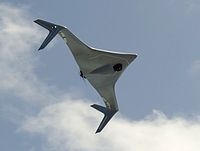
Photo from wikipedia
Chris Woods’ book is an important contribution to the study of why technology is used in today’s asymmetry warfare. Perhaps the most significant form of this is the drones in… Click to show full abstract
Chris Woods’ book is an important contribution to the study of why technology is used in today’s asymmetry warfare. Perhaps the most significant form of this is the drones in the forefront of the ‘War on Terror’ being used to kill enemies, real and imagined. In Sudden Justice: America’s Secret Drone Wars, Woods discusses the emergence of the predators due largely to the bloody price now being paid in light of the unpredictable wars since 9/11. Drone wars cleverly do not put boots on the ground, according to Woods. There is no doubt that ‘armed drones [represent] a new warfare model’ (p. xiii) and appear to be ‘risk-free’ (p. xiv). It is not surprising that the US and its allies opt for the drones, and drones will surely remain as game changers, employed secretly ‘by US Special Forces and the CIA’ (p. 4) despite being controversial for the killing of civilians (p. 7). Consequently, Woods contends that the use of drones is ‘challenging’ with regard to Executive Order 11905 issued by President Ford, which banned assassination by US agencies (p. 62). The author highlights concerns that the drones programme undermines international humanitarian laws. However, ‘Washington may have believed itself to be under no obligation to respect this’ (p. 65). It is doubtful whether the US and its allies will stop the use of drones, as the predators have ‘helped direct in precision fire’ in many of the battle areas in which these countries are engaged (p. 85). Allegations of war crimes as civilian non-combatants are killed apparently matter little and are of no moral concern (p. 171). Drone wars have been entirely abused through their lack of transparency coupled with poor oversight by American lawmakers. And if, as Woods states, ‘consistent oversight only began eight years into the US targeted killings programme’, then one can perhaps imagine what has happened in between the lines (p. 203). Hence, Woods explains why it is difficult for British and American public opinion to question the programme (p. 246). Readers will agree with the author that the ‘short-term tactical benefits of drone strikes were not being weighed against their strategic implications’ and ‘could undermine US relations with those same countries’ considered as allies – if they have not already been undermined, looking at the discontent in Pakistan, Yemen and other hot spots (p. 286). Christopher Woods’ well-balanced analysis is pertinent about the increase in drone warfare. Global leaders should have a rethink, as drones should be considered beyond ‘value on the modern battlefield’ (p. 288). This is part of the reasons why this book is important.
Journal Title: Political Studies Review
Year Published: 2017
Link to full text (if available)
Share on Social Media: Sign Up to like & get
recommendations!